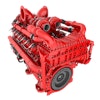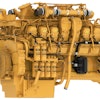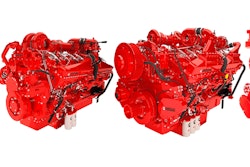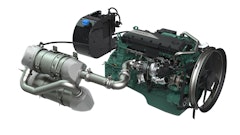
Engines in the off-highway industry are going through many challenges as technology continues evolving. More than ever, companies are trying to be more efficient and sustainable and gain the most they can. This journey, though, is hardly a straight line and continues to challenge companies trying to create reliable engines in environments that are sometimes anything but. Nick Block, director of global marketing and sales, for John Deere Power Systems, addressed some of the challenges they face and how they're working toward a better future for their customers.
How have off-highway engine technologies evolved over the past decade?
One of the bigger misconceptions about off-highway diesel engine technology, I think, is that it has been static while the industry is working to bring hybrid and battery-powered applications online. For John Deere, that couldn’t be further from the truth. We’ve been saying for years that there isn’t a singular, silver bullet solution for the future of power in the off-highway industry. Across our portfolio of products, we are investing in and prioritizing solutions that make the most sense for our customers. That includes continuing to invest in advancing our diesel engine technology to help machines run more cleanly and more efficiently.
We’re doing this by engineering practical solutions that enable the integration of hybrid powertrains, electronic controls, advanced aftertreatment systems, and better compatibility with renewable fuels. Additionally, the prognostic capabilities built into today’s diesel engines are quite remarkable. We initially saw the on-highway market embrace telematics and predictive analytics. With tools like John Deere Connected Support, the off-highway market is catching up; and OEMs and end users can benefit from features like remote diagnostics, maintenance alerts, fleet management tools, and more.
How have emissions regulations like EPA Tier 4 and EU Stage V influenced off-highway engine design and what technologies have helped John Deere meet those standards?
Changing emission standards are never far from mind for OEMs and those that do business in the heavy-duty off-highway equipment space. Battery electric and hybridization will play a key role, especially in lighter-duty equipment segments. But, John Deere knows that there is still a long life ahead for compression ignition diesel engine technology, particularly for heavy-duty off-highway applications, and we are investing in the technology accordingly.
When we set out to design our latest industrial engines, a main driver in our engineering process was to help our customers and stakeholders meet not just current but future emission standards. We’re optimizing these engines through a new engine architecture to more easily integrate electrification and utilize additional fuels beyond traditional diesel fuel. For example, the JD18 and JD14 feature dual overhead cams that will give John Deere the ability to adapt our engines for spark ignition to burn both liquid and gaseous fuels. We’ve also built in auxiliary connections to the engines — something we didn’t have before. They’ll be able to run other electrified functions off the engine’s power. It’s going to give customers a lot more versatility in how they can apply these engines efficiently and sustainably. All of these features are helping to address our OEM customers’ productivity pain points while helping them meet current sustainability goals and plan for future emission changes.
How do emissions control systems impact the maintenance and performance of off-highway engines?
One of the biggest pain points identified by OEMs and end users is the increased complexity of aftertreatment that can come with larger engines. With peak power ratings from 572 to 677 kW (767 to 908 hp) and new combustion technology, the JD18 does not require aftertreatment. This simplifies engine package design for OEMs and means users have one less fluid to manage. Testing has shown the JD18 engine meets emissions standards using only diesel fuel, letting end users eliminate 800 gallons of diesel exhaust fluid (DEF) per year.* That's saving fourteen 55-gallon drums of DEF each year.
When aftertreatment and other emissions control systems are necessary, John Deere is doing everything possible to minimize disruption to equipment design and end user operations. For example, the JD14 features an in-line aftertreatment system, which offers more flexibility for horizontal or vertical mounting. The JD14 also meets Final Tier 4 applications without the need for a diesel particulate filter (DPF), enhancing equipment performance and overall fuel economy.
*Calculations based off DEF consumption from Nebraska Test Data of a Steiger 620 QuadTrac running at 1900 RPMs in 6th gear for 300 hours.
How does John Deere use maintenance practices such as telemetry and predictive maintenance to help improve engine reliability? How is digitization (IoT, sensors and AI) influencing the design and operation of off-highway engines?
The integration of advanced data collection and telematics is undeniably reshaping the maintenance landscape for off-highway equipment. As manufacturers continue to refine these technologies and expand their capabilities, the shift toward proactive maintenance strategies will become even more universal. This evolution not only promises greater efficiency and reduced downtime but also a future where equipment maintenance is smarter, more precise, and inherently more reliable
Predictive analytics allow for the monitoring of standard maintenance and service points and can alert operators, owners, and dealers to potential problems before they arise. By analyzing patterns and irregularities in the data, manufacturers can predict potential failures and empower dealers with those insights to proactively schedule maintenance at the most opportune times.
John Deere has tapped into its vast network of more than half a million connected agricultural, construction, and forestry machines across the world to leverage aggregated engine data to provide an innovative capability called Predictive Alerts. Predictive Alerts combine the collected engine data, diagnostic analytics, and an actionable solution into an alert that, with the end user’s consent, is delivered to the customer’s service dealer of choice. From there, the dealer can address potential engine issues before they happen and reduce repair time so that customers can look forward to improved machine uptime and productivity.
In what ways can the JD18 help operators and companies in the off-highway industry achieve their goals?
I would summarize the benefits of the JD18 in three categories — productivity, efficiency, and future-proofing. The JD18 allows end users to be more productive with a higher power output and heavier duty cycles. Its rugged bedplate design was built for 20,000 hours of operation, so machines can stay at work longer and at a higher horsepower even under harsh working conditions. We prioritized serviceability in the JD18 engine’s design by incorporating features like hydraulic lash adjusters that offer a maintenance-free valvetrain.
Fuel efficiency is another main benefit of the JD18 engine. Improved fuel efficiency translates into power — and power is a competitive advantage in the off-highway market. When designing the JD18, John Deere explored technologies that make the engine more fuel-efficient without sacrificing power output. The result is an engine that provides better fuel economy for improved power, better overall customer value, lower fuel consumption, and, in turn, reduced criteria pollutants.
The last main benefit of the JD18 I would call out is the emphasis our engineering experts have placed on future-proofing the engine’s features as the industry changes. We are investing in our diesel technology and advancing the features that will support fuel efficiency and the reduction of operating emissions. We are doing this by prioritizing the ability to integrate renewable fuels and hybrid systems through auxiliary outputs. We’re also monitoring the Tier 5 development process closely and working with our world-class engineering team to provide the best possible guidance to our original equipment manufacturer (OEM) customers.
What feedback have you received from customers and operators and how has this shaped plans for future engines?
Reception of the JD18 has been very positive. This engine opened up new possibilities for OEMs that were looking to offer more power while benefiting from the rugged durability that they’ve come to expect from John Deere engines. We’ve also heard that the simplified air system with fixed and wastegate turbos has made it easier to integrate the engine. This has also allowed us to offer better package sizing for enhanced efficiency and performance.
From hay grinders to industrial-grade pumps, these engines are out in the field helping end users be more productive with higher horsepower and optimized maintenance intervals. We’re excited to see how even more OEMs integrate our most powerful engine ever in the coming year.
Looking ahead, our focus will continue to be on providing practical, reliable solutions that deliver tangible value to our customers, whether that's through improved efficiency, increased productivity, or enhanced sustainability. Power innovation at John Deere has always emphasized customer value and real-world viability. We’re anticipating the challenges and opportunities that will impact our stakeholders so they can continue to rely on us to develop durable, reliable power solutions that are ready to power their machines through the toughest of jobs.




















